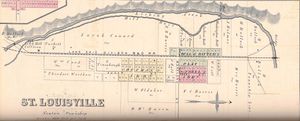Difference between revisions of "St. Louisville"
From Licking County Library's Wiki!
| (3 intermediate revisions by the same user not shown) | |||
| Line 1: | Line 1: | ||
| − | St. Louisville is the largest community and an incorporated village in Newton Township. Located at the northernmost edge of the district, the village is laid out to the east and north of a curve in the North Fork of the Licking River. A railroad line had run through the town since the 1850s and also lies on the west side nearer to the river with a majority of the village's roads and structures lying to the line's east. E.M.P. Brister, in his Centennial History of Newark and Licking County, gave two close dates and two sets of founders: John Bell and Stephen Ritter (1839), and separately, John Evans (1840). The confusion may lie in the initial plans laid out by the former pair and then an expansion of village lots by Evans and a Wesley Coffman. <ref> Brister, E., ''Centennial History of Newark'', (1909), 249, 329 </ref> With the assistance of the railroad, the village grew and numbered 282 inhabitants in 1900. <ref> Brister, E., ''Centennial History of Newark'', (1909), 248 </ref> The Coffman Mill, which required a long mill race between the village and the North Fork, was a prominent early business. In 1883, the village had several grocers, a blacksmith, a physician, and possibly even a hotel run by a John Turbott. <ref> ''Directory of Newark 1883-1884'', (1883), 174 </ref> Today the village has a grocery, several restaurants, and other businesses as well as its own police department. Less than a mile south of St. Louisville, there was once a small community called Houston Mills, or Newton Mills, which acquired the first post office in the township in 1826. The post office and community were superseded by the growth of St. Louisville. <ref> ''Ohio Ghost Towns: No 44 Licking County'', ed. Helwig and Helwig, (1998), 102 </ref> | + | [[File:St louisville 1875 atlas.jpg|thumb|Detail of village of St. Louisville from 1875 Atlas of Licking County.]]St. Louisville is the largest community and an incorporated village in [[Newton Township]]. Located at the northernmost edge of the district, the village is laid out to the east and north of a curve in the North Fork of the Licking River. A railroad line had run through the town since the 1850s and also lies on the west side nearer to the river with a majority of the village's roads and structures lying to the line's east. E.M.P. Brister, in his Centennial History of Newark and Licking County, gave two close dates and two sets of founders: John Bell and Stephen Ritter (1839), and separately, John Evans (1840). The confusion may lie in the initial plans laid out by the former pair and then an expansion of village lots by Evans and a Wesley Coffman. <ref> Brister, E., ''Centennial History of Newark'', (1909), 249, 329 </ref> With the assistance of the railroad, the village grew and numbered 282 inhabitants in 1900. <ref> Brister, E., ''Centennial History of Newark'', (1909), 248 </ref> The Coffman Mill, which required a long mill race between the village and the North Fork, was a prominent early business. In 1883, the village had several grocers, a blacksmith, a physician, and possibly even a hotel run by a John Turbott. <ref> ''Directory of Newark 1883-1884'', (1883), 174 </ref> Today the village has a grocery, several restaurants, and other businesses as well as its own police department. Less than a mile south of St. Louisville, there was once a small community called Houston Mills, or Newton Mills, which acquired the first post office in the township in 1826. The post office and community were superseded by the growth of St. Louisville. <ref> ''Ohio Ghost Towns: No 44 Licking County'', ed. Helwig and Helwig, (1998), 102 </ref> |
Latest revision as of 08:02, 19 July 2022
St. Louisville is the largest community and an incorporated village in Newton Township. Located at the northernmost edge of the district, the village is laid out to the east and north of a curve in the North Fork of the Licking River. A railroad line had run through the town since the 1850s and also lies on the west side nearer to the river with a majority of the village's roads and structures lying to the line's east. E.M.P. Brister, in his Centennial History of Newark and Licking County, gave two close dates and two sets of founders: John Bell and Stephen Ritter (1839), and separately, John Evans (1840). The confusion may lie in the initial plans laid out by the former pair and then an expansion of village lots by Evans and a Wesley Coffman. [1] With the assistance of the railroad, the village grew and numbered 282 inhabitants in 1900. [2] The Coffman Mill, which required a long mill race between the village and the North Fork, was a prominent early business. In 1883, the village had several grocers, a blacksmith, a physician, and possibly even a hotel run by a John Turbott. [3] Today the village has a grocery, several restaurants, and other businesses as well as its own police department. Less than a mile south of St. Louisville, there was once a small community called Houston Mills, or Newton Mills, which acquired the first post office in the township in 1826. The post office and community were superseded by the growth of St. Louisville. [4]
J.G.
Return to Townships and Communities main page.
